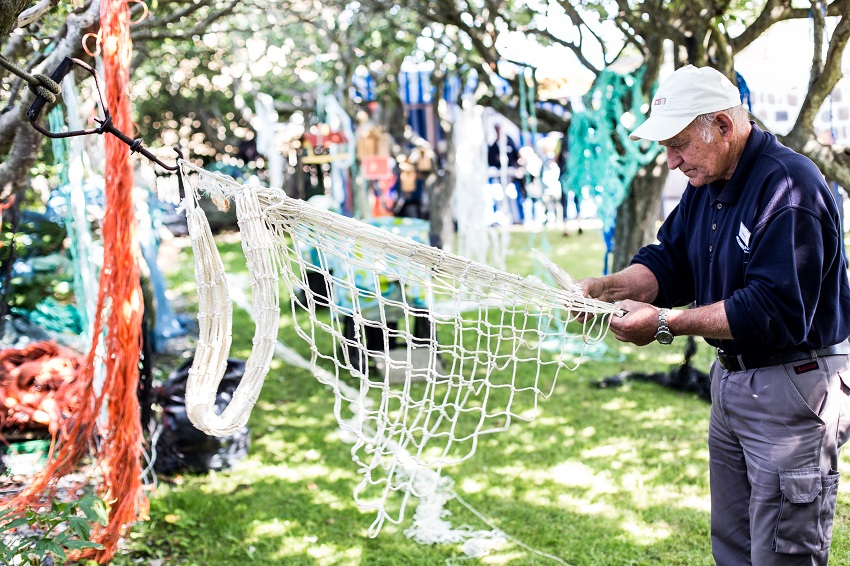“I had stopped some of the activities that I used to and I didn’t recognise myself anymore. Then I decided to take part in this experiment and in a week I’d made great progress in getting back a bit of optimism” Participant, Transparent Boundaries, Italy
Older people are being made to feel valued and recognised in a unique research project which focuses on the beautiful, intricate, skilled, and fading art of lace making.
Transparent Boundaries, a European project led by Lesley Millar, Professor of Textile Culture at the University for the Creative Arts, looks at the invisibility of older generations in contemporary media and culture. According to Professor Lesley Millar, Project Lead, Transparent Boundaries,
“The project set out to answer the question ‘Why doesn’t society recognise older people more in popular culture?’ At a time of an increasing, and increasingly, older population who are only represented in the media when there are problems, Transparent Boundaries aimed to provide a platform for positive, creative outcomes […] Younger artists and practitioners worked side by side with older people to find ways in which the creative contribution of the Elder would be visible and disseminated to the wider population.”
This unique and innovative project has reached the shortlist for the Knowledge Exchange/Transfer Initiative of the Year award as part of the Times Higher Leadership & Management Awards, to be announced later this week.
The multi-disciplinary project, combining performance, dance, textiles, and craft, built on Professor Millar’s previous research project and exhibition in Birmingham’s Museum and Art Gallery, Lost in Lace, which examined the practice of lace making, itself an art form largely disappearing from view.
The project was devised at a time when the awareness and position of older people in society was being increasingly discussed across Europe. Together the academics, artists, and participants from Greece, Italy, Poland, Denmark, and the UK have used the idea of ‘Lace Networks’ to connect elders in different countries and explore their potential to be a positive force in contemporary life through workshops, performances, and academic conferences.
Knowledge Exchange is a hot topic in higher education in the UK, as reflected in this category of awards. Transparent Boundaries is a compelling example of Knowledge Exchange (KE) in the arts and humanities and the nomination is an important acknowledgement of the significant impact on society that can be achieved by these so-called ‘softer subjects’.
KE is a term that has developed from the STEM-led ‘Knowledge Transfer’, where research outcomes are made available and applicable to industry. The shift from ‘transfer’ to ‘exchange’ is not an accident – it means all subject areas can be included in the consideration of how research may be valuable to non-academic communities.
Crucially, the emphasis on “exchange”, not just “transfer” stresses this is a two way process, taking the learning from working with other communities and applying it back to academic thinking and research. Institutions and academics are often grappling with how to not only deliver KE activities but also how to absorb and use what is learnt by them.
Partnerships lead to further activity between communities and institutions through building trust and goodwill, something smaller and more specialist institutions have naturally incorporated through their focus on translational research and widening participation. Successful KE can highlight wider social and economic agendas in a creative and collaborative way. For example, through working with elders with direct experience of traditional industries, the Danish project highlighted the significant changes seen in their region:
“The fishing industry helped shape the North Jutland Identity…Nowadays the inhabitants of this region no longer have any particular connection with the sea and it is this loss that the project and exhibition are seeking to present and address as a problem.” Participant, Transparent Boundaries, Denmark
As the impact agenda continues to dominate, knowledge exchange is a major pathway to generating wider social and economic impacts from research. Research funders are identifying more sophisticated ways to capture and measure the benefits and impact of KE activities. Similarly the funding mechanisms for such activities, including HEIF – Higher Education Innovation Fund, need to keep pace.
Many smaller and specialist institutions are leading the field in knowledge exchange. Still,external funding for KE is limited due to the size of their overall activity. Current funding models are a problem for such institutions. Follow-on schemes to extend impact tend to focus further resources on existing recipients of research funding, and programmes such as HEIF are off-limits due to thresholds that are beyond institutions delivering smaller-scale programmes.
If the full diversity of the UK HE sector is to be mobilised to support the world’s grand challenges – economic growth and productivity, ageing, social inclusion – to name a few – every institution should be encouraged and resourced to achieve their potential to engage and initiate change with local and regional communities beyond the campus.

